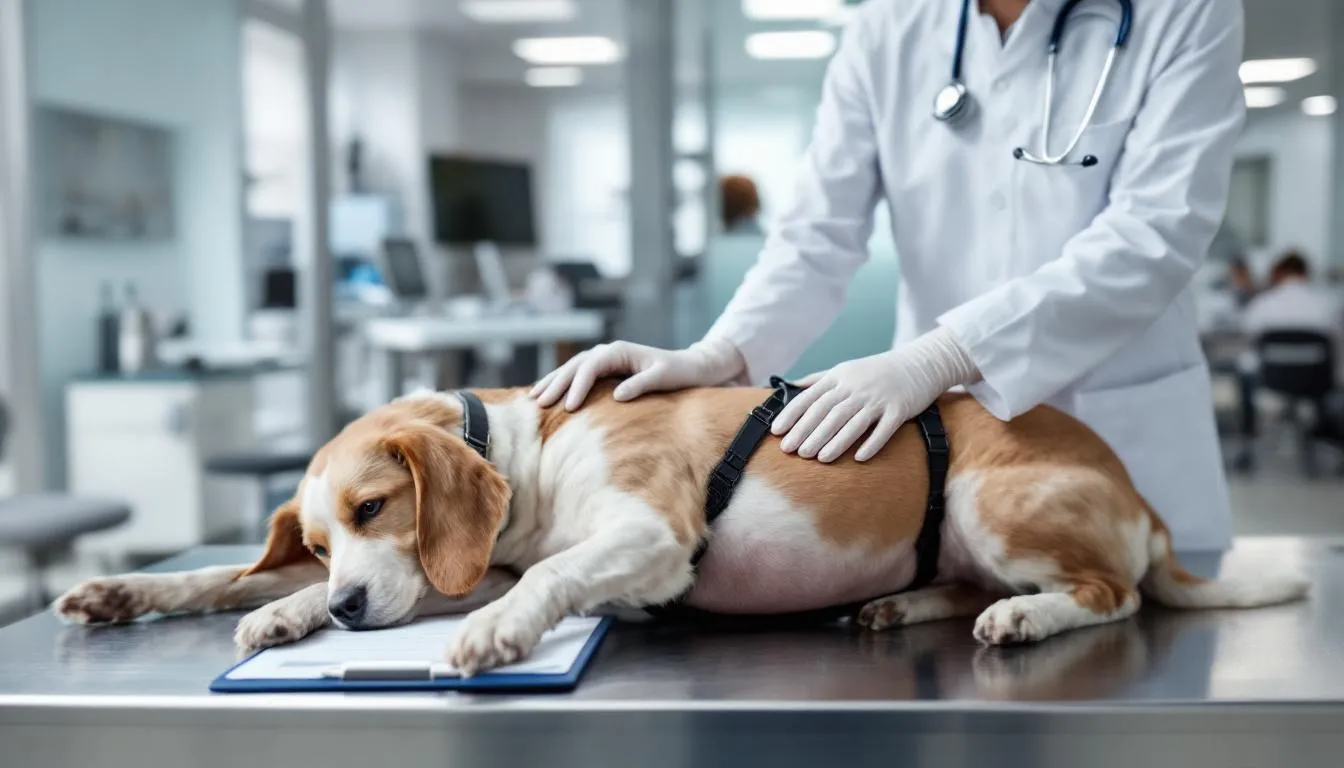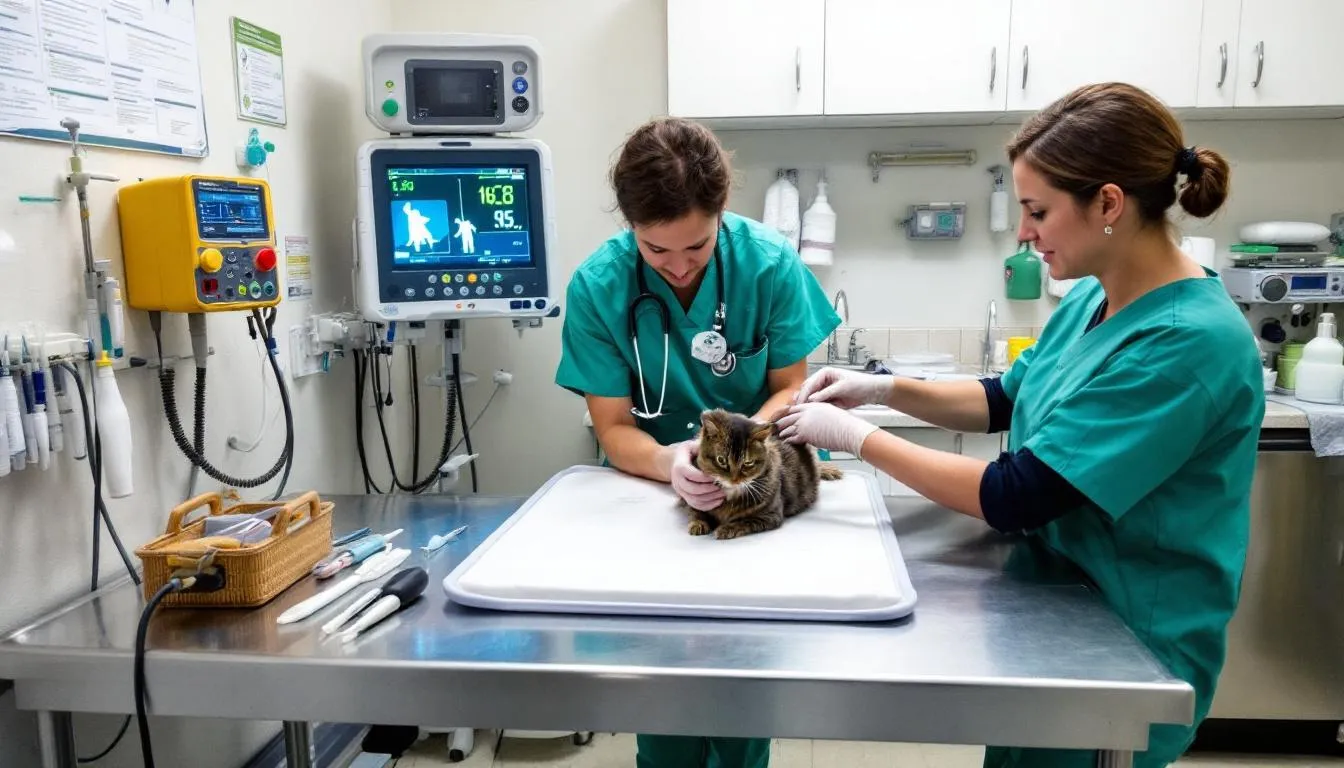Key Takeaways
- Dogs mastitis is inflammation of the mammary glands, primarily affecting nursing female dogs during lactation or postpartum periods.
- Mastitis typically affects female dogs during lactation or postpartum, with early symptoms including swollen, warm mammary glands and discolored milk; severe cases can progress to life-threatening sepsis.
- Bacterial infections, trauma from puppies’ nails, and unsanitary whelping conditions are the most common causes.
- Prompt veterinary diagnosis and treatment are essential, as untreated mastitis can be fatal to both mother and puppies.
- Most cases resolve within two to three weeks with appropriate antibiotic therapy and supportive care.
Dogs mastitis is inflammation of the mammary glands, primarily affecting nursing female dogs during lactation or postpartum periods.
Mastitis typically affects female dogs during lactation or postpartum, with early symptoms including swollen, warm mammary glands and discolored milk; severe cases can progress to life-threatening sepsis.
Bacterial infections, trauma from puppies’ nails, and unsanitary whelping conditions are the most common causes.
Prompt veterinary diagnosis and treatment are essential, as untreated mastitis can be fatal to both mother and puppies.
Most cases resolve within two to three weeks with appropriate antibiotic therapy and supportive care.


What is Canine Mastitis?
Mastitis in dogs refers to inflammation of one or more mammary glands in female dogs, most commonly occurring during the postpartum period when mothers are nursing their litters. This serious medical condition affects the breast tissue and can rapidly progress from mild inflammation to life-threatening infection if left untreated.
The condition typically develops when harmful bacteria enter through the teat canal, often through small wounds or trauma caused by nursing puppies. A dog contracts mastitis when bacteria enter the mammary gland through trauma or unsanitary conditions. The mammary gland becomes a breeding ground for infection, particularly when milk stasis occurs due to blocked milk ducts or sudden weaning. Female dogs have multiple mammary glands extending from the chest to the groin area, and mastitis can affect one or several glands simultaneously.
Bacterial infection is the primary driver of mastitis, with common pathogens including Staphylococcus aureus, Streptococcus species, and E. coli. These bacteria are often present in the environment and can exploit any breach in the mammary tissue’s natural defenses. Unsanitary whelping conditions significantly increase the risk, as contaminated bedding and poor hygiene expose the vulnerable mammary tissue to a higher bacterial load.
Types of Mastitis in Dogs
Understanding the different forms of mastitis helps recognize the severity and urgency of treatment needed. Each type presents distinct challenges and requires specific management approaches.
Acute mastitis represents the sudden onset form, characterized by rapid development of severe swelling, heat, and pain in the affected gland. The mammary gland becomes noticeably enlarged and tender, often causing the mother to avoid nursing or show signs of discomfort when puppies attempt to feed. This form can progress quickly and requires immediate veterinary attention.
Chronic mastitis or subclinical mastitis presents more subtly, with persistent low-grade inflammation that may go unnoticed for extended periods. This form often manifests as gradual changes in milk production or quality, with newborn puppies showing poor weight gain as the primary indicator. The affected gland may feel slightly firmer or irregular compared to healthy mammary tissue.
Septic mastitis involves bacterial or fungal infection with systemic involvement. Dogs with this condition show fever, lethargy, loss of appetite, and obvious illness beyond the local mammary gland changes. The infection has spread beyond the local tissue, affecting the dog’s overall health and requiring aggressive treatment.
Gangrenous mastitis represents the most severe form, where tissue death occurs in the affected gland. The mammary tissue appears dark purple or black, feels cold to the touch, and may develop open wounds. This form constitutes a veterinary emergency, as the necrotic tissue can lead to septic shock and death without immediate surgical intervention.


Symptoms and Clinical Signs
Early detection of mastitis requires careful observation of both the nursing dog and her puppies. The clinical signs progress from subtle changes to obvious illness, making regular monitoring essential during the lactation period.
Initial symptoms often include slight swelling of one or more mammary glands, with the affected gland feeling warmer than normal to the touch. The mother may show mild discomfort when puppies nurse from the affected area, occasionally repositioning herself or gently discouraging nursing from specific teats. During this early stage, puppies milk from the affected gland may appear slightly thicker or have a different color than normal.
As mastitis progresses, the swollen mammary glands become more pronounced, with visible inflammation and heat radiating from the affected tissue. The mammary gland may feel hard or lumpy, and milk expressed from the affected area shows obvious discoloration - appearing bloody, yellowish, or containing visible clots or pus. The teat canal may appear red or swollen, and the surrounding skin often shows signs of irritation.
Severe symptoms such as extreme pain, dark discoloration, or pus discharge indicate a need for emergency care. In severe cases, the affected glands develop a darker appearance, sometimes progressing to purple or black discoloration indicating tissue death. The nursing dog shows obvious signs of systemic illness including fever, vomiting, loss of appetite, and extreme lethargy. She may completely refuse to allow puppies to nurse and show marked behavioral changes including depression and withdrawal from her maternal duties.
White blood cells increase significantly in severe infection, and the dog may develop signs of septic shock including rapid heart rate, pale gums, and difficulty maintaining normal blood pressure. These symptoms indicate a medical emergency requiring immediate veterinary intervention.
Common Causes and Risk Factors
Multiple factors contribute to the development of mastitis, with bacterial infection serving as the primary underlying cause. Understanding these risk factors helps prevent the condition and enables early intervention when risk situations arise.
Bacterial infection occurs most commonly when harmful microorganisms enter through trauma to the mammary tissue. Nursing puppies create multiple opportunities for bacterial entry through their sharp nails, which can scratch and create small wounds in the delicate mammary tissue. Even minor scratches provide entry points for bacteria normally present on the skin or in the environment.
Environmental factors play a crucial role in mastitis development. Unsanitary whelping areas with damp, dirty bedding create ideal conditions for bacterial growth and increase the likelihood of mammary gland contamination. Poor hygiene during the pregnant dogs’ final weeks and throughout the nursing period significantly elevates risk.
Milk stasis represents another major contributing factor, occurring when milk accumulation builds up in the mammary gland due to blocked ducts, infrequent nursing, or sudden weaning. When milk remains stagnant in the mammary tissue for prolonged periods, it creates an environment conducive to bacterial growth and inflammation.
Trauma and stress during pregnancy and lactation can compromise the immune system and increase susceptibility to infection. Physical trauma beyond normal nursing activities, such as rough handling or injuries from other animals, can damage mammary tissue and create infection opportunities.
Certain female dogs may have increased predisposition due to anatomical factors, previous mastitis episodes, or underlying health conditions that affect immune function. Multiple glands involvement often indicates more serious underlying factors or environmental contamination.


Veterinary Diagnosis
To diagnose mastitis, veterinarians rely on a combination of physical examination, laboratory testing, and sometimes imaging studies. Accurate diagnosis requires comprehensive evaluation using these veterinary procedures. Early diagnosis significantly improves treatment outcomes and reduces complications for both mother and puppies.
The physical exam focuses on thorough mammary gland assessment, evaluating each gland for size, temperature, consistency, and pain response. Veterinarians examine the quality and characteristics of milk expressed from each teat, noting color, consistency, and presence of abnormal material. A complete patient history helps identify potential predisposing factors and timeline of symptom development.
Laboratory tests provide crucial diagnostic information. A complete blood count reveals elevated white blood cells indicating infection and helps assess the severity of systemic involvement. Blood chemistry panels evaluate organ function and identify complications such as dehydration or metabolic disturbances that may require additional treatment.
Milk cytology involves microscopic examination of mammary gland secretions to identify inflammatory cells, bacteria, and other abnormal findings. This test helps differentiate between septic and non septic mastitis and provides immediate information about the infection type and severity.
Bacterial culture and sensitivity testing identify the specific organisms causing infection and determine which antibiotics will be most effective. While culture results take several days, this information guides targeted antibiotic therapy and helps avoid antimicrobial resistance development.
Advanced diagnostic techniques may include ultrasound examination to evaluate mammary tissue structure, identify abscesses, and assess blood flow to the affected areas. In severe cases, additional imaging helps determine the extent of tissue damage and guide surgical planning if needed.
Managing Early Mastitis
Managing early mastitis in dogs is essential to halt the progression of inflammation and protect both the mother and her puppies. Early mastitis often presents with subtle clinical signs, such as mild inflammation of the mammary glands, slight redness, increased warmth, and tenderness when touched. Owners may also notice a decrease in milk production or mild milk discoloration, which can be the first indication that something is amiss.
At the first sign of these changes, it is important to contact your veterinarian for a thorough evaluation. Early mastitis in dogs responds best to prompt intervention, which may include a course of prescribed antibiotics to address any underlying bacterial infection before it becomes severe. Your veterinarian will also assess the affected mammary glands and may recommend supportive care, such as gentle hand-milking to relieve milk accumulation and prevent further milk stasis.
Maintaining excellent hygiene is crucial during this stage. Keep the mammary area clean and dry, and ensure that the whelping environment is free from contaminants that could worsen the infection. Regularly monitor the clinical signs in your dog, checking for any increase in swelling, changes in milk color, or signs of discomfort during nursing.
With early detection and appropriate treatment, most cases of mild mastitis in dogs resolve quickly, allowing the mother to continue caring for her puppies without interruption. Consistent monitoring and veterinary guidance are key to ensuring a swift recovery and preventing the development of more serious complications.
Treatment Options
Effective treatment depends on the type and severity of mastitis, ranging from outpatient management for mild cases to intensive hospitalization for severe infections. Veterinarians use a range of approaches to treat mastitis, depending on severity. Early intervention significantly improves outcomes and reduces complications.
Mild mastitis often responds well to outpatient treatment with oral antibiotics and supportive care. Veterinarians typically prescribe antibiotics based on common bacterial pathogens while awaiting culture results, then adjust therapy based on sensitivity testing. Pain medications help alleviate discomfort and encourage continued nursing when appropriate.
Hand-milking the affected glands every 6 hours helps maintain milk flow and prevents further milk stasis. This technique requires gentle pressure and proper hygiene to avoid introducing additional bacteria. The expressed milk should be discarded until the infection resolves and milk quality returns to normal.
Supportive therapies include warm compresses applied to the affected mammary tissue to encourage blood flow and reduce inflammation. Some veterinarians recommend mild cold compresses alternated with warm applications to manage swelling and pain. Cabbage leaves applied to the mammary gland for 2-4 hours can provide natural anti-inflammatory effects.
Severe mastitis requires more aggressive treatment including hospitalization for intravenous fluid therapy, injectable antibiotics, and intensive monitoring. These cases may need surgical intervention if abscesses develop or if gangrenous tissue requires removal to prevent systemic complications.
The decision about whether to continue nursing depends on the severity of infection and the safety of the milk for the puppies. In mild cases, the mother may be able to nurse puppies from unaffected glands, which helps maintain milk production, provides nutrition for the litter, and assists in milk drainage. However, if the infection is severe or the milk is unsafe, nursing may need to be temporarily halted and puppies should be hand-fed to ensure they remain nourished.
Impact on Nursing Puppies
Mastitis significantly affects nursing puppies through multiple mechanisms, making early detection and treatment crucial for both maternal and neonatal health. Understanding these impacts helps guide treatment decisions and puppy care strategies.
Milk quality changes represent the most immediate concern for nursing puppies. Infected mammary glands produce milk with altered composition, potentially containing bacteria, inflammatory cells, and toxic substances that can harm developing puppies. The milk may taste different, causing puppies to refuse nursing from affected glands and leading to inadequate nutrition.
Toxic milk syndrome can develop when puppies consume milk from severely infected glands, leading to digestive upset, failure to thrive, and potentially life-threatening illness in young animals. Signs include lethargy, poor weight gain, diarrhea, and general failure to develop normally.
Fading puppy syndrome may result from poor maternal care when the mother experiences pain and illness from mastitis. Affected mothers may neglect normal maternal behaviors including nursing, cleaning, and temperature regulation, leaving puppies vulnerable to hypothermia, dehydration, and malnutrition.
Veterinary guidance helps determine whether puppies can safely continue nursing during treatment. In cases of mild inflammation or early mastitis, continued nursing from unaffected glands may be possible with close monitoring. However, severe infection typically requires separation and hand-feeding to protect puppy health.
When hand-feeding becomes necessary, proper milk replacer formulation and feeding schedules are critical for puppy survival and development. This intensive care requires significant time commitment and veterinary oversight to ensure adequate nutrition and prevent complications associated with artificial feeding.


Prognosis and Recovery
The outlook for dogs with mastitis varies significantly based on the timing of diagnosis, severity of infection, and response to treatment. Understanding prognostic factors helps set realistic expectations and guides treatment intensity.
Early detection and prompt veterinary treatment typically result in excellent outcomes, with most mild to moderate cases resolving completely within two to three weeks. Dogs receiving appropriate antibiotic therapy and supportive care usually return to normal mammary gland function without long-term complications.
A severe case of mastitis, especially when advanced or complicated, carries a more guarded prognosis, particularly when systemic infection or gangrenous changes develop. In some instances, a severe case can progress to a blood borne infection, leading to systemic illness and an uncertain prognosis. These cases may require surgical removal of affected mammary tissue and intensive supportive care to prevent life-threatening complications. If the blood supply to the mammary tissue is compromised, tissue death can occur, resulting in gangrenous mastitis and other serious complications. Recovery may take longer, and some dogs may experience permanent changes to mammary gland function.
Factors affecting prognosis include the dog’s overall health status, the specific bacterial organisms involved, and the speed of treatment initiation. Younger, healthier dogs generally recover more quickly than older animals or those with underlying health conditions that may compromise immune function.
Long-term monitoring is essential following mastitis treatment, as some dogs may experience recurrence in subsequent pregnancies. Veterinary follow-up helps ensure complete resolution and provides guidance for preventing future episodes through improved management practices.
The impact on future breeding depends on the extent of mammary tissue damage. Most dogs retain normal reproductive function and can successfully nurse future litters, though extra precautions may be warranted to prevent recurrence.
Prevention Strategies
Preventing mastitis requires comprehensive management focusing on hygiene, environmental control, and regular monitoring throughout pregnancy and lactation. Effective prevention strategies significantly reduce the incidence and severity of mammary gland infections.
Environmental management forms the foundation of mastitis prevention. Maintaining clean, dry whelping areas with daily bedding changes eliminates bacterial reservoirs and reduces contamination risk. The whelping box should be designed to promote drainage and allow easy cleaning, with non-porous surfaces that can be thoroughly disinfected between uses.
Puppy management includes regular nail trimming to minimize trauma to mammary tissue during nursing. Puppies’ nails should be trimmed weekly starting at a few days of age to prevent scratching and wound creation. Ensuring all mammary glands receive regular nursing helps prevent milk stasis and maintains healthy milk flow.
Hygiene protocols during pregnancy and the postpartum period include regular cleaning of the mammary area and monitoring for early signs of problems. Pregnant dogs should receive appropriate grooming and mammary gland examination as part of routine prenatal care.
Weaning management requires gradual reduction in nursing frequency rather than abrupt separation, which can lead to painful engorgement and milk buildup. A controlled weaning process over several days allows mammary glands to adjust milk production gradually and reduces inflammation risk.
Health monitoring includes daily examination of mammary glands during lactation, checking for heat, swelling, or changes in milk quality. Weight monitoring of puppies provides early indication of nursing problems that may signal developing mastitis in the mother.


When to Seek Emergency Care
Recognizing emergency situations helps ensure rapid treatment and prevents life-threatening complications. Certain signs indicate immediate veterinary attention is required, regardless of time of day or availability of regular veterinary services.
Immediate emergency signs include mammary glands that appear hot, extremely painful, and dark red or purple in color. These changes suggest rapid progression toward gangrenous mastitis, which can become life-threatening within hours without surgical intervention.
Systemic illness indicators require emergency care, including high fever, extreme lethargy, vomiting, complete loss of appetite, and signs of shock such as pale gums or rapid heart rate. These symptoms suggest the infection has spread beyond the local mammary tissue and is affecting overall body function.
Gangrenous mastitis presents with black discoloration of mammary tissue, extremely hard glands that feel cold to the touch, and sometimes open wounds with foul-smelling discharge. This condition represents tissue death and requires immediate surgical removal of necrotic tissue to prevent fatal septic shock.
Puppy-related emergencies include situations where all puppies are unable to nurse due to maternal illness, or when puppies show signs of toxic milk syndrome including lethargy, vomiting, or failure to respond normally to stimulation.
When calling emergency veterinary services, provide specific information about the dog’s condition, timeline of symptom development, and current status of the nursing puppies. This information helps the veterinary team prepare for immediate care and may influence treatment recommendations even before arrival at the clinic.
FAQ
Can mastitis occur in non-pregnant or non-lactating female dogs?
While rare, mastitis can occasionally develop in pseudopregnant females due to hormonal changes that stimulate milk production without actual pregnancy. It can also occur following mammary gland trauma in any female dog, though it’s most common in nursing mothers during the postpartum period.
How long should I wait before contacting a veterinarian if I suspect mastitis?
Contact your veterinarian immediately upon noticing any mammary gland changes, as mastitis can progress rapidly from mild symptoms to life-threatening conditions within hours. Early intervention significantly improves outcomes and reduces the risk of complications for both mother and puppies.
Is it safe to use home remedies like warm compresses before seeing a vet?
Only use gentle warm compresses if specifically advised by your veterinarian, as inappropriate heat application can worsen inflammation and delay proper diagnosis and treatment. Professional veterinary evaluation should always be the first step when mastitis is suspected.
Can mastitis recur in future pregnancies?
Yes, dogs who have experienced mastitis are at higher risk for recurrence in subsequent pregnancies, making preventive measures and close monitoring especially important. Maintaining excellent hygiene, proper whelping conditions, and regular veterinary checkups help reduce recurrence risk.
What should I do if my dog refuses to nurse her puppies due to mastitis pain?
Contact your veterinarian immediately for guidance on pain management and puppy feeding alternatives, as prolonged separation from nursing can worsen milk stasis and complicate treatment. The veterinarian can prescribe appropriate pain medication and advise whether hand-feeding the puppies is necessary.
FAQ
Can mastitis occur in non-pregnant or non-lactating female dogs?
While rare, mastitis can occasionally develop in pseudopregnant females due to hormonal changes that stimulate milk production without actual pregnancy. It can also occur following mammary gland trauma in any female dog, though it’s most common in nursing mothers during the postpartum period.
How long should I wait before contacting a veterinarian if I suspect mastitis?
Contact your veterinarian immediately upon noticing any mammary gland changes, as mastitis can progress rapidly from mild symptoms to life-threatening conditions within hours. Early intervention significantly improves outcomes and reduces the risk of complications for both mother and puppies.
Is it safe to use home remedies like warm compresses before seeing a vet?
Only use gentle warm compresses if specifically advised by your veterinarian, as inappropriate heat application can worsen inflammation and delay proper diagnosis and treatment. Professional veterinary evaluation should always be the first step when mastitis is suspected.
Can mastitis recur in future pregnancies?
Yes, dogs who have experienced mastitis are at higher risk for recurrence in subsequent pregnancies, making preventive measures and close monitoring especially important. Maintaining excellent hygiene, proper whelping conditions, and regular veterinary checkups help reduce recurrence risk.
What should I do if my dog refuses to nurse her puppies due to mastitis pain?
Contact your veterinarian immediately for guidance on pain management and puppy feeding alternatives, as prolonged separation from nursing can worsen milk stasis and complicate treatment. The veterinarian can prescribe appropriate pain medication and advise whether hand-feeding the puppies is necessary.






